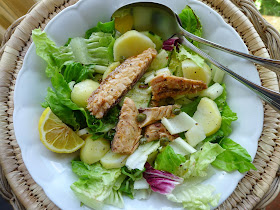 |
| Quesada pasiega, a Spanish cheesecake. |
I’ve had cheesecake on the brain. Not sure why. But instead of indulging in a rich, New York-style cheesecake, I decided to make a Spanish recipe, quesada pasiega, which is more like a cheese custard and ever-so-easy to put together.
“Pasiega” comes from the Valley of Pas in Cantabria, northern “green” Spain, which is famous for its cheeses. Traditionally, this dessert is made with fresh cheese curd (cuajado), before it is shaped and cured on the way to becoming cheese. But it is easy to adapt to any sort of fresh, soft cheese—fromage blanc, ricotta, requesón, quark, unsalted cottage cheese, thick Greek yogurt.
I used requesón, similar to ricotta, a soft curd cheese tasting of fresh milk, instead of Pasiego cheese curds for this cheesecake.
Please note that this recipe has one very exotic ingredient—butter! If you are a regular follower of my blogs about Spanish cooking you may have noticed (or, perhaps not) that butter never appears in the recipes. In Spanish cooking, and in my own kitchen, olive oil is the fat of choice. However, I just happened to have a tub of butter left behind by a guest. And, as Cantabria is a land of verdant meadows, rolling hills and pastures where cows graze, butter and cheese are part of the region’s cuisine.
Bread crumbs give this custard consistency. Use 4 or 5 slices of day-old bread, crusts removed. Break the bread into pieces and pulse in a food processor until the bread is reduced to medium crumbs. You should have about 2 cups of crumbs. (Some recipes for quesada call for flour instead of bread crumbs.)
The quesada is good served with a fruit compote (see the recipe for pears in sweet wine here) or strawberry puree.
 |
| Quesada pasiega cut into squares for serving. |
Cheese Custard Squares
Quesada Pasiega
1 cup milk
2 strips lemon zest
2-inch cinnamon stick
2 cups fresh bread crumbs
3 tablespoons softened butter
¾ cup sugar
3 eggs
2 cups fromage blanc, ricotta or other unsalted fresh cheese
Cinnamon to garnish (optional)
Combine the milk, lemon zest and cinnamon stick in a small saucepan. Bring to a boil and remove from heat. Let cool to lukewarm. Remove zest and cinnamon.
Set aside 3 tablespoons of bread crumbs. Place the remaining crumbs in a food processor and pour over the milk. Process until smooth.
Preheat oven to 350ºF. Butter a 13X9 inch rectangular baking pan and sprinkle with the reserved 3 tablespoons of bread crumbs.
Cream the butter in a mixing bowl (or add directly to the food processor). Beat in the sugar, then the eggs, one by one. Beat in the the fresh cheese. Stir in the bread and milk mixture.
Pour the batter into the baking pan. Bake until the custard is set and a skewer comes out clean, about 45 minutes.
Allow to cool in the pan. Loosen the edges and turn out onto a work surface. Cut the custard into pieces approximately 3 by 2 inches and arrange them on a serving platter. Dust with cinnamon, if desired.















